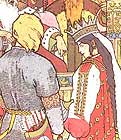


Sixty Folk-Tales From Exclusively Slavonic Sources by A. H. Wratislaw
Return
to
Sixty Folk-Tales
Table of Contents
Upper
and Lower Lusatian Stories
XIV.
Right Always Remains Right
Kashubian
Story
Polish
Stories
Introduction
XVIII.
The Spirit of a Buried Man
Introduction
to Polish Stories
THE Polish language is one of great beauty and flexibility, but it is disfigured by an orthography which causes English readers to imagine that it is very difficult to pronounce, which is by no means the case. The letter z in Polish performs the office frequently assigned to h in English, viz., that of softening the preceding consonant without possessing any further power of its own. Thus cz is the exact equivalent in Polish of our ch, and sz exactly represents our sh. The other grand peculiarities of the Polish language are the sibillated r, written rz, the retention of the nasal sounds of long a (as on) and long e (as en in French), and the dull l represented by a curved stroke through the letter l, which has the sound of our final ll in 'bull,' but is somewhat difficult to pronounce at the beginning or in the middle of a word.
Poland, or rather Lithuania, the aristocracy of which is Polish, has produced a really great poet, Mickiewicz, whose poems are so beautiful, that it would be worth while for a literary person of leisure to study the language for the mere purpose of reading them. See Morfill's Russia (Sampson Low, 1880), pp. 207-272. One of the most celebrated of Mickiewicz's poems, Pan Taddeus, has lately been translated by Miss M. A. Biggs (Trübner and Co.).
In the Polish story, No. 17, we make acquaintance with Kostchey the Deathless, who plays a great part in Russian stories, but is entirely unknown by name among the southern and most of the western Slavonians. His place is with them taken by dragons and evil shapes of various kinds. His name is probably derived from kost, a 'bone,' and I have ventured to Anglicize it accordingly. He is generally supposed to symbolize winter, and certainly deciduous trees and bushes then exhibit a very skeleton-like appearance. In a story from the government of Perm, given by Mr. Ralston, the secret of his immortality is discovered, and he is put to death accordingly. But I cannot help inferring that his death is of annual occurrence, and that he resumes his reign annually at the proper season, to be again put to death towards spring. With No. 18 several Russian tales given by Mr. Ralston (pp. 185-193) may be compared. No. 19 is a singular story of a more Oriental than European cast, and No. 20 reads as much like a dream dreamed after the consumption of a considerable quantity of vodka, as a genuine Folklore story. Such is also the case with several of Crofton Croker's Legends of the South of Ireland.
Tale No. 17 has already appeared in the Folklore Journal for January, 1884. For mere beauty of construction and narration I doubt whether its equal can be found in any language.
The text came from:
Wratislaw, A. H. Sixty Folk-Tales From Exclusively Slavonic Sources. Boston: Houghton, Mifflin, & Company, 1890.

©Heidi
Anne Heiner, SurLaLune Fairy Tales
E-mail: surlalune@aol.com
Page last updated September 18, 2006
www.surlalunefairytales.com



